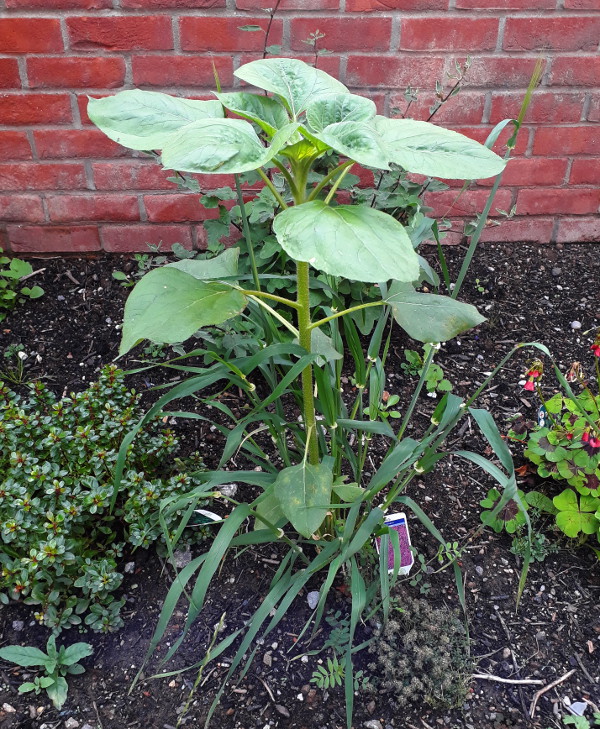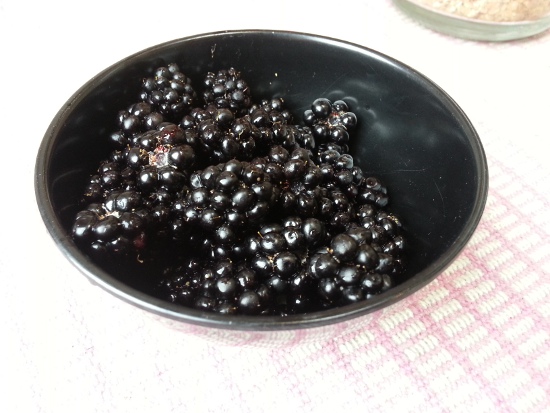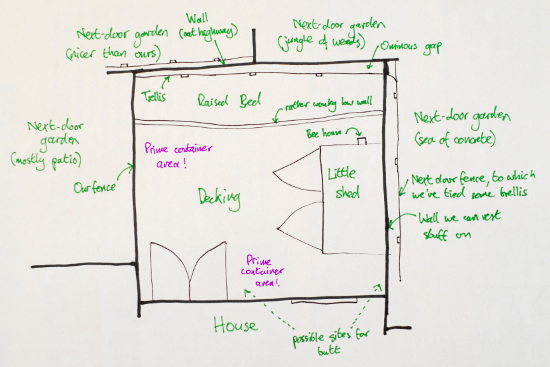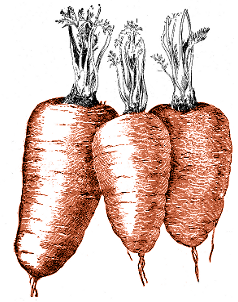Posted in Garden Diary on Saturday, August 14th 2021 (9.22 PM).
If there were any regular readers of this blog, they would have noticed that since the last post, when the garden was being radically relandscaped, there haven’t been any further updates. Well, the landscaping has finished since then, the garden now has a lawn, an apple tree and a variety of beds which are slowly being populated with plants. So far, of course, the plants all appear to be tiny little things somewhat dwarfed by the amount of empty bare earth between them, but that will slowly change.
This post, though, is something of an aside, before I get around to the Proper Post with a map of the garden and summaries of some of the plants that have been scattered about. Because between a couple of plants which had been properly planted, a strange weed grew up. It started growing and grew up fast; and it seemed to have a strange mixture of leaves, some of them long and thin like a grass and some broad and heart-shaped. In other words almost as if it was a chimera of two completely different types of plant, half-monocotelydon and half-dicotelydon. Outside of science fiction, that’s completely and utterly impossible.
Well, I looked at it more closely today, and I’ve realised what it is. Take a look yourself and see if you can spot it.

So what sort of plant is it, that I’ve realised I have? It’s a bird food plant, of course!
No, really, look. In the middle, that’s a typical sunflower stem with its flower forming at the centre. Round the outside, some sort of cereal plant, possibly barley. Why on earth would you have a sunflower and a few stems of barley all germinating in exactly the same spot? Because a small lump of bird seed cake was dropped there and has started to grow, of course.
Whether it was accidentally dropped by a passing jackdaw or wood pigeon, or whether it was in the topsoil when it arrived and has germinated now it has light, I don’t know and will never know. The topsoil certainly does have a good number of weed seeds in it, a significant proportion of them nettles, so it possibly was in the soil before it was spread out. The sunflower has probably started a little late in the season for best results, but it will be interesting to see just how high and fast it manages to grow before autumn. If it flowers, I’ll make sure I take a picture.
weeds, weed, sunflower, helianthus
Posted in Garden Diary, Planning, Retrospective, The Old Garden In Bristol on Saturday, September 7th 2013 (10.29 PM).
Regular readers of this site – all one of you – might have noticed that things have been rather quiet for a while here. There is, of course, a good reason for that. The reason is: the state of the garden, in the second half of last year, was such a disaster that I really didn’t feel like writing about it. I really didn’t feel like going into the garden. And so, nothing was put away for the winter, everything was left to fend for itself. A surprising amount of plants survived the winter, but the ones that did were mostly killed off by the heat earlier this summer. So now, effectively, we are starting again. The only produce we’ve had from the garden in 2013 is a small bowl from an interloper, something very tasty that we didn’t really ask for.

For some reason, gardening tasks always seem to end up involving brambles. I can dimly remember, aged about 5, my grandfather giving my parents a bramble shoot with the advice to keep it in a bucket lest it take over the whole garden. Naturally, by the time I had reached my teens, it had taken over, well, half the garden (the rest was lawn), and I spent what seems in memory to be most of a summer cutting it down, piece by piece, first with secateurs then with hacksaw, until my parents’ only option was to hire a wood chipper to deal with the pile of chunks. At the previous place we lived in Bristol, there was virtually no garden, and the only gardening task I ever did was regularly chop back a bramble which had managed to root itself under the decking. They really are amazing plants, in their ability to cover an area, take it over, turn everything underneath into a barren desert, and like bindweed they are endemic in this part of Bristol. So when I saw bramble runners sprouting forth over our back fence and dropping down seeking earth, I knew it had to go. After we’d eaten its fruit, of course.
The origin of the bramble is quickly explained, if we skip back to the garden plan posted a couple of years back:

That area at top-right marked “Jungle of weeds” was all dug up about a year ago. They now have a shed, backing on to our boundary, and a high wooden fence extending off to the right. However, the cleared land on their side of said fence has been left to revert back to weediness. With their new fence, there is now double the Ominous Gap marked on the plan, and it’s this gap which has been colonised by bramble. I can reach down and chop off anything threatening to poke its way over into our space, but I have no hope at all of digging up the roots. In other words, my life is once again doomed to regularly cutting back brambles.
Apart from the bramble-hacking, what are we going to do now that we’ve admitted we’re going to restart from scratch? Try to plant things that don’t take as much nursing, for one thing, so that the garden will survive if we want a summer holiday; and things that don’t necessarily look appetising to every slug and snail in town. Lots of herbs, lots of insect-attracting flowers, and maybe the odd item of produce that we can’t easily buy here. For now, we’ve cut down the weeds that were colonising the back bed and sowed white clover for the winter, to refresh its nitrates and try to give the weeds no space to come back. Before the winter, we’ll start growing a bulb’s worth of garlic, and sow our spring flowers: of all last year’s produce, the garlic was the best harvest, and was barely touched by pests. Then, next year, hopefully things will be green again.
blackberry, bramble, clover, garlic, weeds, white clover




